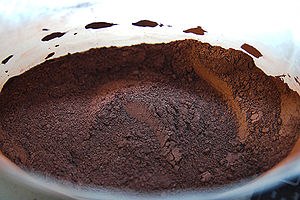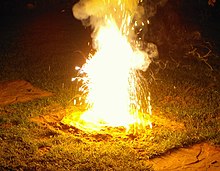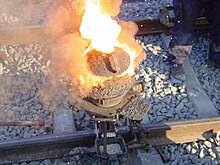Thermite: Difference between revisions
Reverted 1 edit by 222.225.181.137; Rv trivia link. (TW) |
If removed again, please leave a statement why the inserted link is not appropriate! The article about thermite discovered in the WTC dust is based on scientific research and it is very related. |
||
| Line 105: | Line 105: | ||
* [http://www.theodoregray.com/PeriodicTable/Samples/026.17/index.video.s12.html Video - steel casting with thermite] |
* [http://www.theodoregray.com/PeriodicTable/Samples/026.17/index.video.s12.html Video - steel casting with thermite] |
||
* [http://www.degussa-history.com/geschichte/en/inventions/thermite.html History of thermite] |
* [http://www.degussa-history.com/geschichte/en/inventions/thermite.html History of thermite] |
||
* [http://www.bentham-open.org/pages/content.php?TOCPJ/2009/00000002/00000001/7TOCPJ.SGM Active Thermitic Material Discovered in Dust from the 9/11 World Trade Center Catastrophe] |
|||
{{Refimprove|date=September 2007}} |
{{Refimprove|date=September 2007}} |
||
Revision as of 23:16, 19 April 2009

Thermite is a pyrotechnic composition of a metal powder and a metal oxide, which produces an aluminothermic reaction known as a thermite reaction. It is not explosive, but can create short bursts of extremely high temperatures focused on a very small area for a short period of time.
Thermites can be a diverse class of compositions. The fuels are often aluminium, magnesium, calcium, titanium, zinc, silicon, and boron. The oxidizers can be boron(III) oxide, silicon(IV) oxide, chromium(III) oxide, manganese(IV) oxide, iron(III) oxide, iron(II,III) oxide, copper(II) oxide, and lead(II,II,IV) oxide. [1]
The most common thermite is aluminium-iron(III) oxide.
The aluminium reduces the oxide of another metal, most commonly iron oxide, because aluminium is highly combustible:
- Fe2O3 + 2Al -> 2Fe + Al2O3 + Heat
The products are aluminium oxide, free elemental iron, and a large amount of heat. The reactants are commonly powdered and mixed with a binder to keep the material solid and prevent separation.
The reaction is used for thermite welding, often used to join rail tracks. Other metal oxides can be used, such as chromium oxide, to generate elementary metal. Copper thermite, using copper oxide, is used for creating electric joints in a process called cadwelding:
- 3CuO + 2Al -> 3Cu + Al2O3 + Heat
Some thermite-like mixtures are used as pyrotechnic initiators such as fireworks.
Thermites with nanosized particles are described through a variety of terms, such as metastable intermolecular composites, superthermite[1] nanothermite,[2] and nanocomposite energetic materials.[3][4]
History

The Thermite (Thermit) reaction was discovered in 1893 and patented in 1895 by German chemist Hans Goldschmidt. Consequently, the reaction is sometimes called the "Goldschmidt reaction" or "Goldschmidt process". Dr. Goldschmidt was originally interested in producing very pure metals by avoiding the use of carbon in smelting, but he soon realized the value in welding.
The first commercial application was the welding of tram tracks in Essen, in 1899. Evonik, formerly Degussa, a corporate descendant of Goldschmidt's firm, is still today one of the world's largest producers of welding thermite.
Types

Black or blue iron oxide (Fe3O4), produced by oxidizing iron in an oxygen-rich environment under high heat, is the most commonly used thermite oxidizing agent because it is inexpensive and easily produced. Red iron(III) oxide (Fe2O3, commonly known as rust) can also be used. Other oxides are occasionally used, such as MnO2 in manganese thermite, Cr2O3 in chromium thermite, or copper(II) oxide in copper thermite, but only for highly specialised purposes. All examples use aluminium as the reactive metal. Fluoropolymers can be used in special formulations, Teflon with magnesium or aluminium being a relatively common example. Magnesium/teflon/viton is another pyrolant of this type.
In principle, any reactive metal could be used instead of aluminium. This is rarely done, however, because the properties of aluminium are ideal for this reaction. It is by far the cheapest of the highly reactive metals; it also forms a passivation layer making it safer to handle than many other reactive metals. The melting and boiling points of aluminium also make it ideal for thermite reactions. Its relatively low melting point (660 °C, 1221 °F) means that it is easy to melt the metal, so that the reaction can occur mainly in the liquid phase[5] and thus proceeds fairly quickly. At the same time, its high boiling point - 2,519 °C (4,566 °F) - enables the reaction to reach very high temperatures, since several processes tend to limit the maximum temperature to just below the boiling point.[6] Such a high boiling point is common among transition metals (e.g. iron and copper boil at 2,887 °C (5,229 °F) and 2,582 °C (4,680 °F) respectively), but is especially unusual among the highly reactive metals (cf. magnesium and sodium which boil at 1,090 °C (1,990 °F) and 883 °C (1,621 °F) respectively). Further, the low density of the aluminium oxide formed as a result of the reaction tends to cause it to float on the iron, reducing contamination of the weld.
Although the reactants are stable at room temperature, they burn with an extremely intense exothermic reaction when they are heated to ignition temperature. The products emerge as liquids due to the high temperatures reached (up to 2500 °C (4500 °F) with iron(III) oxide)—although the actual temperature reached depends on how quickly heat can escape to the surrounding environment. Thermite contains its own supply of oxygen and does not require any external source of air. Consequently, it cannot be smothered and may ignite in any environment, given sufficient initial heat. It will burn well while wet and cannot be extinguished with water. Small amounts of water will boil before reaching the reaction. If thermite is ignited underwater, the molten iron produced will extract oxygen from water and generate hydrogen gas in a single-replacement reaction. This gas may, in turn, burn by combining with oxygen in the air.
Ignition
Metals are capable of burning under the right conditions, similarly to the combustion process of wood or gasoline. In fact, rust is the result of oxidation of steel or iron at very slow rates. A thermite reaction is a process in which the correct mixture of metallic fuels are combined and ignited. Ignition itself requires extremely high temperatures.
Ignition of a thermite reaction normally requires only a simple child's sparkler or easily obtainable magnesium ribbon, but may require persistent efforts, as ignition can be unreliable and unpredictable. Thermite reactions require very high temperatures for initiation. These temperatures cannot be reached with conventional black powder fuses, nitrocellulose rods, detonators, a suitable pyrotechnic initiator, or other common igniting substances. Even when the thermite is hot enough to glow bright red, it will not ignite as it must be at or near white-hot to initiate the reaction. It is possible to start the reaction using a propane torch if done correctly. The torch can preheat the entire pile of thermite which will make it explode instead of burning slowly when it finally reaches ignition temperature.
Often, strips of magnesium metal are used as fuses. Because metals burn without releasing cooling gases, they can potentially burn at extremely high temperatures. Reactive metals such as magnesium can easily reach temperatures sufficiently high for thermite ignition. Magnesium ignition remains popular among amateur thermite users, mainly because it can be easily obtained.
The reaction between potassium permanganate and glycerine or ethylene glycol is used as an alternative to the magnesium method. When these two substances mix, a spontaneous reaction will begin, slowly increasing the temperature of the mixture until flames are produced. The heat released by the oxidation of glycerine is sufficient to initiate a thermite reaction. However, this method can also be unreliable and the delay between mixing and ignition can vary greatly due to factors such as particle size and ambient temperature.
Apart from magnesium ignition, some amateurs also choose to use sparklers to ignite the thermite mixture. These reach the necessary temperatures and provide enough time before the burning point reaches the sample. However, this can be a dangerous method, as the iron sparks, like the magnesium strips, burn at thousands of degrees and can ignite the thermite even though the sparkler itself is not in contact with it. This is especially dangerous with finely powdered thermite.
Similarly, finely-powdered thermite can be ignited by a regular flint spark lighter, as the sparks are burning metal (in this case, the highly-reactive rare-earth metals lanthanum and cerium). Therefore it is unsafe to strike a lighter close to thermite.
A stoichiometric mixture of finely powdered iron(III) oxide and aluminium may be ignited using ordinary red-tipped book matches by partially embedding one match head in the mixture, and igniting that match head with another match, preferably held with tongs in gloves to prevent flash burns.
Civilian uses



Thermite reactions have many uses. Thermite is not an explosive but instead operates by exposing a very small area of metal to extremely high temperatures. Intense heat focused on a small spot can be used to cut through metal or weld metal components together by melting a very thin film where the components meet.
Thermite may be used for repair by the welding in-place of thick steel sections such as locomotive axle-frames where the repair can take place without removing the part from its installed location. It can also be used for quickly cutting or welding steel such as rail tracks, without requiring complex or heavy equipment. However, defects such as slag inclusions and holes are often present in such welded junctions and great care is needed to operate the process successfully.
A thermite reaction, when used to purify the ores of some metals, is called the Thermite process, or aluminothermic reaction. An adaptation of the reaction, used to obtain pure uranium, was developed as part of the Manhattan Project at Ames Laboratory under the direction of Frank Spedding. It is sometimes called the Ames process.
Copper thermite is used for welding together thick copper wires for the purpose of electrical connections. It is used extensively by the electrical utilities and telecommunications industries (Exothermic Welded Connections).
Military uses
Thermite hand grenades and charges are typically used by armed forces in both an anti-material role and in the partial destruction of equipment, the latter being common when time is not available for safer or more thorough methods. Because standard iron-thermite is difficult to ignite, burns with practically no flame and has a small radius of action, standard thermite is rarely used on its own as an incendiary composition. It is more usually employed with other ingredients added to enhance its incendiary effects. Thermate-TH3 is a mixture of thermite and pyrotechnic additives which have been found to be superior to standard thermite for incendiary purposes. Its composition by weight is generally 68.7% thermite, 29.0% barium nitrate, 2.0% sulfur and 0.3% binder (such as PBAN). The addition of barium nitrate to thermite increases its thermal effect, produces a larger flame, and significantly reduces the ignition temperature. Although the primary purpose of Thermate-TH3 by the armed forces is as an incendiary anti-material weapon, it also has uses in welding metal components.
A classic military use for thermite is disabling artillery pieces, and has been used commonly for this purpose since the Second World War. Thermite can permanently disable artillery pieces without the use of explosive charges and therefore can be used when silence is necessary to an operation. There are several ways to do this. By far the most destructive method is to weld the weapon shut by inserting one or more armed thermite grenades into the breech and then quickly closing it. This makes the weapon impossible to load. An alternative method is to insert an armed thermite grenade down the muzzle of the artillery piece, fouling the barrel. This makes the piece very dangerous to fire. Yet another method is to use thermite to weld the traversing and elevation mechanism of the weapon, making it impossible to aim properly.
Thermite was also used in both German and Allied incendiary bombs during World War II. Incendiary bombs usually consisted of dozens of thin thermite-filled canisters (bomblets) ignited by a magnesium fuse. Incendiary bombs destroyed entire cities due to the raging fires that resulted from their use. Cities that primarily consisted of wooden buildings were especially susceptible. These incendiary bombs were utilized primarily during night time air raids. Bomb sights could not be used at night, creating the need to use munitions that could destroy targets without the need for precision placement.
Hazards
Thermite usage is hazardous due to the extremely high temperatures produced and the extreme difficulty in smothering a reaction once initiated. The thermite reaction releases dangerous ultra-violet (UV) light requiring that the reaction not be viewed directly, or that special eye protection (for example, a welder's mask) be worn. Small streams of molten iron released in the reaction can travel considerable distances and may melt through metal containers, igniting their contents. Additionally, flammable metals with relatively low boiling points such as zinc, whose boiling point of 907 °C (1665 °F) is about 1370 °C (2500 °F) below the temperature at which thermite burns, could potentially boil superheated metal violently into the air if near a thermite reaction, where it could then burst into flame as it is exposed to oxygen.
Preheating of thermite before ignition can easily be done accidentally, for example by pouring a new pile of thermite over a hot, recently-ignited pile of thermite slag. When ignited, preheated thermite can burn almost instantaneously, releasing a much greater amount of light and heat energy than normal and causing burns and eye damage at what would normally be a reasonably safe distance.
The thermite reaction can take place accidentally in industrial locations where abrasive grinding and cutting wheels are used with ferrous metals. Using aluminium in this situation produces an a mixture of oxides which is capable of a violent explosive reaction.[7]
Mixing water with thermite or pouring water onto burning thermite can cause a steam explosion, spraying hot fragments in all directions.
Thermite's main ingredients were also utilized for their individual qualities, specifically reflectivity and heat insulation, in a paint coating or dope for the Hindenburg, possibly contributing to its fiery destruction. This was a theory put forward by former NASA scientist Addison Bain, and later tested in small scale by the reality science television show MythBusters with semi-inconclusive results (it wasn't proven to be the thermite reaction's fault but instead was conjectured to be a mix between that and the hydrogen filling the Hindenburg). [8]
See also
References
Notes
- ^ Low-Cost Production of Nanostructured Super-Thermites,
- ^ Development of Nanothermite Composites with Variable Electrostatic Discharge Ignition Thresholds
- ^ Reaction Kinetics and Thermodynamics of Nanothermite Propellants
- ^ Generation of fast propagating combustion and shock waves with copper oxide/aluminum nanothermite composites
- ^ or rather, where the solid oxide particles meet the liquid metal
- ^ i.e. loss of fuel and heat due to vaporization
- ^ Fireball from Aluminium and Grinding Dust
- ^ The Best Science Show on Television?
Bibliography
- L. L. Wang, Z. A. Munir and Y. M. Maximov (1993). "Thermite reactions: their utilization in the synthesis and processing of materials". Journal of Materials Science. 28 (14): 3693–3708. doi:10.1007/BF00353167.
- M. Beckert (2002). "Hans Goldschmidt and the aluminothermics". Schweissen und Schneiden. 54 (9): 522–526.
- "DEGUSSA page on thermite".
External links
- Thermite Pictures & Videos (Including Exotic Thermite)
- Video - steel casting with thermite
- History of thermite
- Active Thermitic Material Discovered in Dust from the 9/11 World Trade Center Catastrophe
This article needs additional citations for verification. (September 2007) |
